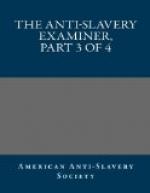The whole number of slaves is one hundred and thirty. Of these, only three are over forty years old. There are thirty-five females between the ages of sixteen and thirty-three, and yet there are only THIRTEEN children under the age of thirteen years!
It is impossible satisfactorily to account for such a fact, on any other supposition, than that these thirty-five females were so overworked, or underfed, or both, as to prevent child-bearing.
The other advertisement is that of a “Probate sale,” ordered by the Court of the Parish of Jefferson—including the slaves of Mr. William Gormley. The whole number of slaves is fifty-one; the sex, age, and accustomed labors of each are given. The oldest of these slaves is but thirty-nine years old: of the females, thirteen are between the ages of sixteen and thirty-two, and the oldest female is but thirty-eight—and yet there are but two children under eight years old!
Another proof that the slaves in the south-western states are over-worked, is the fact, that so few of them live to old age. A large majority of them are old at middle age, and few live beyond fifty-five. In one of the preceding advertisements, out of one hundred and thirty slaves, only three are over forty years old! In the other, out of fifty-one slaves, only two are over thirty-five; the oldest is but thirty-nine, and the way in which he is designated in the advertisement, is an additional proof, that what to others is “middle age,” is to the slaves in the south-west “old age:” he is advertised as “old Jeffrey.”
But the proof that the slave population of the south-west is so over-worked that it cannot supply its own waste, does not rest upon mere inferential evidence. The Agricultural Society of Baton Rouge, La., in its report, published in 1829, furnishes a labored estimate of the amount of expenditure necessarily incurred in conducting “a well-regulated sugar estate.” In this estimate, the annual net loss of slaves, over and above the supply by propagation, is set down at TWO AND A HALF PER CENT! The late Hon. Josiah S. Johnson, a member of Congress from Louisiana, addressed a letter to the Secretary of the United States’ Treasury, in 1830, containing a similar estimate, apparently made with great care, and going into minute details. Many items in this estimate differ from the preceding; but the estimate of the annual decrease of the slaves on a plantation was the same—TWO AND A HALF PER CENT!
The following testimony of Rev. Dr. Channing, of Boston, who resided some time in Virginia, shows that the over-working of slaves, to such an extent as to abridge life, and cause a decrease of population, is not confined to the far south and south-west.




